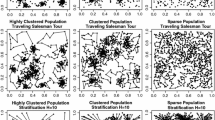Abstract
We introduce a two-step method to perform spatio-temporal balanced sampling in a design-based approach. For populations with spatio-temporal trends and with anisotropic effects in the variable of interest, the prediction can be further improved by selecting samples that are well spread over the entire population in space and time. We control the spread of the sample over the population by using the volume of the corresponding three-dimensional Voronoi tessellation. Indeed, spatio-temporal design-based balanced sampling is even more efficient under the presence of a trend and anisotropic effects. We present an intensive simulation study comparing our method to other available methods for spatio-temporal sampling. Finally, we analyze real data by sampling from a population of temperature stations over six European countries.





Similar content being viewed by others
References
Aarts EH, Korst J (1989) Simulated annealing and boltzman machines. Wiley, New York
Brown PJ, Le ND, Zidek JV (1994) Multivariate spatial interpolation and exposure to air pollutants. Can J Stat 2:489–509
Brus DJ, Heuvelink GBM (2007) Optimization of sample patterns for universal kriging of environmental variables. Geoderma 138:86–95
Christakos G (2005) Random field models in earth sciences. Dover, New York
Cochran WG (1977) Sampling techniques, 3rd edn. Wiley, New York
Cox LA Jr (1999) Adaptive spatial sampling of contaminated soils. Risk Anal 19:1059–1069
Cressie N, Wikle CK (2011) Statistics for spatio-temporal data. Wiley, Hoboken
Delmelle E, Goovaerts P (2009) Second-phase sampling designs for non-stationary spatial variables. Geoderma 153:205–216
Deville JC, Tillé Y (2004) Efficient balanced sampling: the cube method. Biometrika 91:893–912
Dobbie MJ, Henderson BL, Stevens DL Jr (2008) Sparse sampling: spatial design for monitoring stream networks. Stat Surv 2:113–153
Du Q, Wang D (2005) The optimal centroidal voronoi tessellations and the Gersho’s conjecture in the three-dimensional space. Comput Ind Eng 49:1355–1373
Fuentes M, Chaudhuri A, Holland DM (2007) Bayesian entropy for spatial sampling design of environmental data. Environ Ecol Stat 14:323–340
Gneiting T (2001) Criteria of Pólya type for radial positive definite functions. Proc Am Math Soc 129:2309–2318
Gneiting T, Schlather M (2004) Stochastic models that separate fractal dimension and the Hurst effect. SIAM Rev 46:269–282
Goovaerts P (1997) Geostatistics for natural resources evaluation. Oxford University Press, Oxford
Grafström A, Tillé Y (2013) Doubly balanced spatial sampling with spreading and restitution of auxiliary totals. Environmetrics 24:120–131
Grafström A, Lundström NLP, Schelin L (2012) Spatially balanced sampling through the pivotal method. Biometrics 68:514–520
Haining RP (2003) Spatial data analysis: theory and practice. Cambridge University Press, Cambridge
Handcock MS, Stein ML (1993) A Bayesian analysis of kriging. Technometrics 35:403–410
Horvitz DG, Thompson DJ (1952) A generalization of sampling without replacement from a finite universe. J Am Stat Assoc 47:663–685
Li LF, Wang JF, Cao ZD, Feng XL, Zhang LL, Zhong ES (2008) An information-fusion method to regionalize spatial heterogeneity for improving the accuracy of spatial sampling estimation. Stoch Environ Res Risk A 22:689–704
Lister AJ, Scott CT (2009) Use of space-filling curves to select sample locations in natural resource monitoring studies. Environ Model Assess 149:71–80
Mateu J, Müller WG (2013) Spatio-temporal design. Advances in efficient data acquisition. Wiley, Chichester
Matheron G (1971) The theory of regionalized variables and its application. Ecole Nationale Supérieure des Mines de Paris, France
Müller WG (2005) A comparison of spatial design methods for correlated observations. Environmetrics 16:495–505
Müller WG, Zimmerman DL (1999) Optimal designs for variogram estimation. Environmetrics 10:23–37
Müller P, Sanso B, De Iorio M (2004) Optimal Bayesian design by inhomogeneous Markov chain simulation. J Am Stat Assoc 99:788–798
Neyman J (1934) On the two different aspects of the representative method: the method of stratified sampling and the method of purposive selection. J R Stat Soc Ser B Stat Methodol 97:558–606
Rogerson PA, Delmelle E, Batta R, Akella M, Blatt A, Wilson G (2004) Optimal sampling design for variables with varying spatial importance. Geogr Anal 36:177–194
Royall RM, Herson J (1973) Robust estimation in finite populations I. J Am Stat Assoc 68:880–889
Spöck G, Pilz J (2010) Spatial sampling design and covariance-robust minimax prediction based on convex design ideas. Stoch Environ Res Risk A 24:463–482
Stein A, Ettema C (2003) An overview of spatial sampling procedures and experimental design of spatial studies for ecosystem comparisons. Agric Ecosyst Environ 94:31–47
Stevens DL Jr, Olsen AR (2004) Spatially-balanced sampling of natural resources. J Am Stat Assoc 99(465):262–278
Tillé Y (2006) Sampling algorithms. Spinger, New York
Trujillo-Ventura A, Ellis JH (1991) Multiobjective air pollution monitoring network design. Atmos Environ 25:469–479
Valliant R, Dorfman AH, Royall RM (2000) Finite population sampling and inference: a prediction approach. Wiley, New York
van Groenigen JW, Siderius W, Stein A (1999) Constrained optimisation of soil sampling for minimisation of the kriging variance. Geoderma 87:239–259
Wang JF, Haining RP, Cao ZD (2010) Sample surveying to estimate the mean of a heterogeneous surface: reducing the error variance through zoning. Int J Geogr Inf Sci 24:523–543
Yates F (1949) Sampling methods for censuses and surveys. Griffin, London
Zhu Z, Stein ML (2006) Spatial sampling design for prediction with estimated parameters. J Agric Biol Environ Stat 11:24–49
Zimmerman DL, Homer KE (1991) A network design criterion for estimating selected attributes of the semivariogram. Environmetrics 2:425–441
Acknowledgements
The authors are thankful to the referees for their many helpful comments that greatly improved this paper. We also wish to acknowledge for the support from Ordered and Spatial Data Center of Excellence of the Ferdowsi University of Mashhad.
Author information
Authors and Affiliations
Corresponding author
Rights and permissions
About this article
Cite this article
Khavarzadeh, R., Mohammadzadeh, M. & Mateu, J. A simple two-step method for spatio-temporal design-based balanced sampling. Stoch Environ Res Risk Assess 32, 457–468 (2018). https://doi.org/10.1007/s00477-017-1409-9
Published:
Issue Date:
DOI: https://doi.org/10.1007/s00477-017-1409-9




